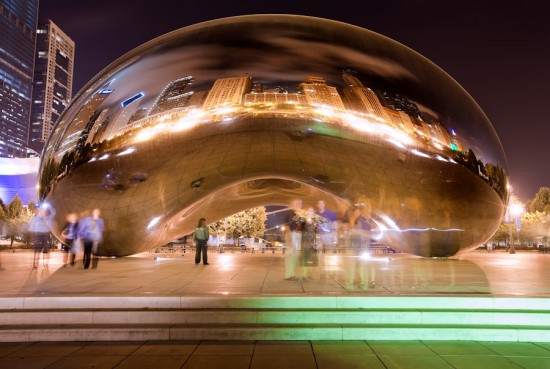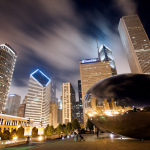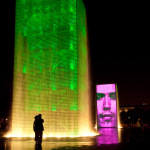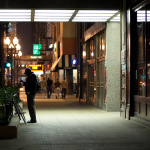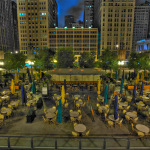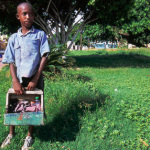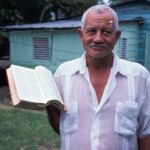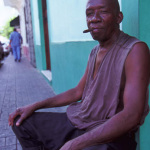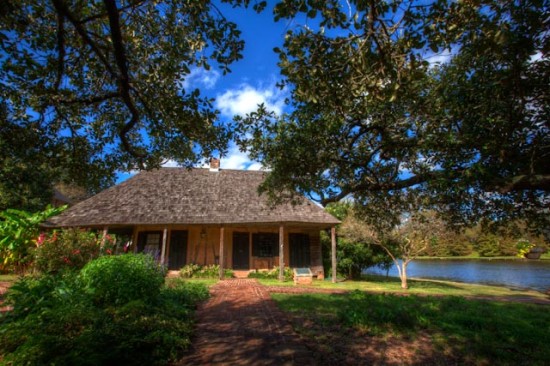
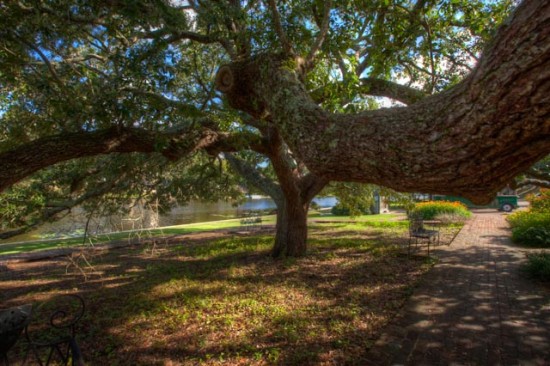
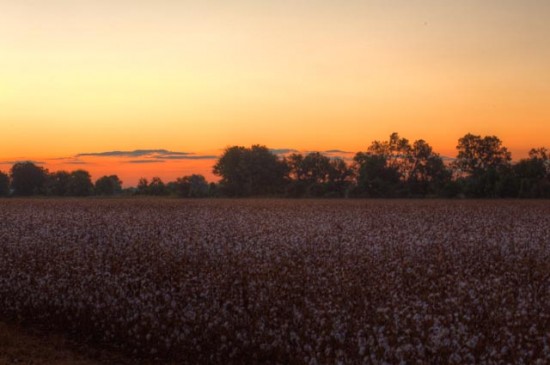
Category: Still Photography
Photographic image made by Jeff Gatesman. Digital, film and HDR photography
Two Nights In Baton Rouge
I’m told it’s a four-hour drive from Shreveport to Baton Rouge, but my recent run-in with Louisiana Highway Patrol has me setting the cruise control to keep me traveling at a safely under-the-radar ramble through the forests and over the bayou’s of this lovely state, and it actually takes me slightly closer to five hours to get to my destination, which is a lighting rental house where we will load a 40′ trailer with the the tools of our trade.
Baton Rouge is the state capitol of Louisiana, sits along the banks of the Mississippi River, and it is quite apparent that most of the activity here centers around the campus of the Louisiana State University, and, at least this week, that means football. It’s a big game weekend where the LSU Tigers are hosting their mortal enemy, the Florida Gators and the town seems just on the verge of going crazy. Frat houses are being completely wrapped with thick black plastic sheeting either to hold out, or hold in the enthusiastic revelers (I haven’t figured that one out yet), little tent villages are springing up on every available lawn, and there is a total ban on parking anywhere near the campus, so in my spare few minutes of time for exploring, I head toward the city center.
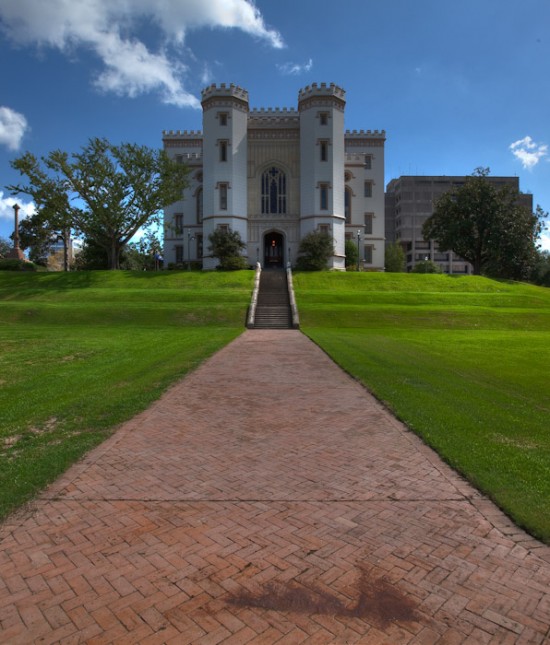
This beautiful building which resembles a castle, is the former state Capitol building and now functions as a History museum. Directly across the street from it is an old railroad terminal that also serves as a museum, and the Mississippi River.

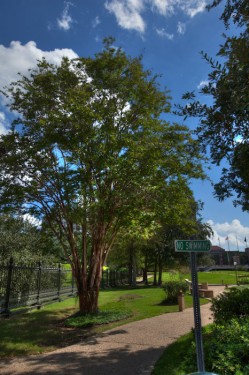
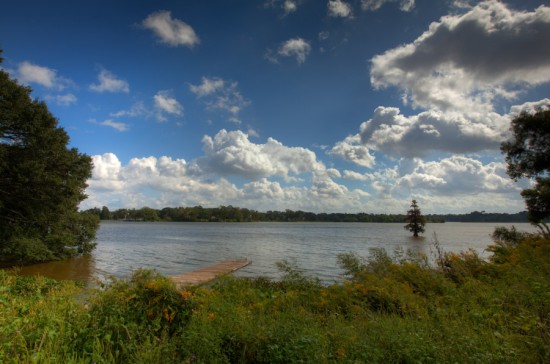
I had to stop and get one photo of University Lake, which sits on the eastern edge of the campus of LSU before heading back toward Shreveport.
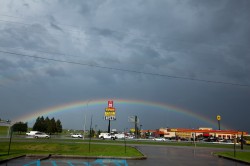
For the three days we were in Baton Rouge it was very hot and humid with big billowy cumulus clouds hanging lazily in the sky, but as we crossed over the Mississippi River on our way back to Shreveport, the skies clouded over and we found ourselves in a driving rain with hellbent wind that kept tossing our car around the freeway. This went on for about 45 minutes until we stopped outside Lafayette for gas and the rain stopped and this gorgeous double rainbow appeared.
Shreveport, LA. Part One
Pre-production for the latest feature film I am working on has begun in and around Shreveport, LA, a city built on oil money which seems to be fairly wet, with lush green landscapes and some of the prettiest sunsets I have seen in awhile. Hopefully I will find an interesting point of view of this place over the next 2 months and, through my lens, bring it to you.
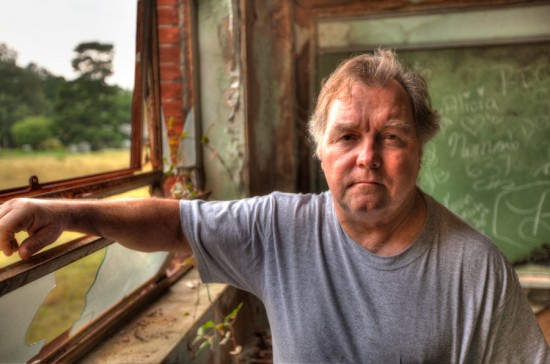
A lot of the buildings seem to be crumbling well before their time in this part of the country, as if they get saturated with all the humidity and rain, and then the real storms come through and just tear open the already weakened structures.


And then there are the mosquitos. This Pump Jack is deep in some woods near Oil City, LA and apparently the center of all things Mosquito. In this photo Ken Ballantine, our Best Boy, models the latest in personal Mosquito attire. They are so thick in this wood that they practically create a haze in the air, in fact they are so dense that you cannot eliminate their bites, you can only minimize them.
More Shreveport to come…
One Night in Chicago
Harleys and HDR
This week I took a trip out to the Salton Sea to try and find a place I had been to 10 or 12 years ago, where the sea had encroached on a small town and partially gobbled up several of the buildings. I thought this would be a great place to make some more images and practice my new found HDR techniques.
Unfortunately (or fortunately for the folks who live there) the interesting place I was looking for no longer exists. Some years ago they had built a berm around the town to hold the water back and destroyed all the buildings that had been eaten away by the extremely salty water.
 Jakob on the berm at Bombay Beach
Jakob on the berm at Bombay Beach
That’s the thing about adventures, you have to expect them to be disappointing sometimes. But the bright side is that I got some more pretty cool images, like the one above of my friend from Copenhagen, Jakob, standing atop the berm.
As I learn more about HDR I think my images will get better. I knew enough to look for the high contrast scene like the one above which, using typical photography would have been a blue sky with silhouettes of the berm and Jakob.
 ” alt=”” border=”0″ />Two Harleys on Rt 78
” alt=”” border=”0″ />Two Harleys on Rt 78
I have some more images from this trip to work on, but I’ve got to get to work, so more later…
First shot at High Dynamic Range

Art Tool
Bits. That is what it all comes down to: bits of color information. The more bits per pixel, the closer an image gets to the range we can see by eye. These days that number is 32, and generally requires several exposures from a digital camera to reach that depth. I remember the first High Dynamic Range (HDR) image I saw. It was a spectacular photo of a crane in a Japanese shipping yard, with hyper-real colors and a sharpness that made it look pretty much like an illustration.

Pier
he managed to squeeze out of the process was at least as spectacular; more so when you consider his methods were blindly based on notions of zones, a complete understanding of the chemistry involved, and all the darkroom skills it took in getting the image from negative to paper. But that is not what this is about… yet. I just took my first step into the world of HDR today, on a beautifully crisp day in southern California, and came up with a couple images without too much hassle at all.

Roller Coaster
Head Shots

Hot Head
In Hollywood everyone is looking for the perfect headshot: an image actors use to market themselves and/or their looks to producers who may be angling to cast someone in a production. This is a very subjective area of photography. Every agent has their own opinion or idea of how their “client” should look in a headshot. Some photographers say it is a scam. I had an inspiration to create some of my own, with a little playful angle.
Drum Head
Large Format Printing from a 20-year old slide

One of my clients came across some images from her days as a model in New York and she wanted to have one of the 35mm slides blown up to a 44″ wide print. This presented a couple of challenges and some fun creative choices to mull over.
First, we decided to send the slide out to West Coast Imaging and have a Tango Drum scan done to create the 200mg file rather than rely on interpolation/sharpening techniques to get the image big enough. Once we had a nice, large file to work from I began the process of smoothing out the tonal range and adding some contrast. Very little retouching was needed, but I wanted to maintain the vintage look of the original slide without dating it so I pretty much cleaned up the noise in the background by smoothing the highlights, then I smoothed out the skintones with a median filter.
The resulting image looked great on a monitor. I printed it on Somerset Velvet paper which has a pretty high D-Max and incredible tonal range. The final print measures 43″ wide by 37″ high and it is every bit as beautiful as the image above.
A Quiet Bright Reedsong
 In school I learned that composition, emulsion, color, exposure, distortion, depth of field, are important elements in creating an image; creating a way for the viewer to see things through your eyes.
In school I learned that composition, emulsion, color, exposure, distortion, depth of field, are important elements in creating an image; creating a way for the viewer to see things through your eyes.
When I had the opportunity to spend time with a group of Whirling Dervishes from Turkey, I learned a lot of things about culture, music and life, but when I struggled with printing the images I had made from that brief time, I found that the right exhibit medium is every bit as important a decision as camera techniques. Silver-gel printing techniques did not quite capture the time I spent with the Dervishes: I was looking for images that were both timeless and yet portrayed the Semazens (as they are called in Turkey) as they are: devout; simple; kind. During this time I stumbled upon the process of lith printing and found the soft tonal distribution and colorful mid-tones to perfectly represent my image of the dervishes. When I further treat the prints in a hot bath of selenium the color turns to a warm brown and adds excellent archival protection.
I have published the series in my portfolio. If you are interested in prints from this series, they come in 8” X 10” and 11” X 14” copies on fine art lith paper from Sterling. Contact me directly for pricing.
Dominican Republic
While shooting a project in the Dominican Republic for Microsoft I spent a little time walking through a barrio just outside of Santo Domingo. At first there weren’t many people around, but an old woman invited me into her home to show me photos of her son who was serving with the U.S. Army.
By the time I had gotten out of the house, word had gotten around and the project Producer and myself had gone from anonymous to a curiosity to celebrity. Soon the streets were buzzing with activity and my camera was drawing a lot of attention from the neighborhood children. At one point an old man waved me into his yard. He really wanted me to see his bible, for some reason.
Later, back in Santo Domingo I came across a few other kids playing in the street. They were all very interested in the camera and really wanted their pictures taken. Soon they swarmed around me like a band of bees. More kids kept coming out from alleyways, huts, seemingly everywhere. Soon I was swimming in a sea of children.
Not sure why the people of the DR are so interested in just having their pictures taken. They were not like people from any other place I had been to: most 3rd world countries, people want you to take their picture, but then they have their hands out, and in America… well, I’m from Hollywood which has it’s own brand of jaded-ness, but most folks here won’t let you take a photo of them before first negotiating the price. Not in the DR. They just simply seemed to be excited about having their pictures taken.





